|
|
Review PDA Fujitsu Siemens Pocket LOOX N500/N520
Standard kit:
- PDA
- USB-cable for synchronization
- Charger
- Extra stylus
- Manual, CD with the software
As you probably remember, a dominating theme of the reports devoted
to Computex
2005 was satellite navigation. And indeed, for the branch in
the whole GPS navigation is a ring-buoy, which it is trying to catch.
The main makers either have already offered their GPS solutions
or are going to. And if the solution is not integrated, then it
is at least a separate package with a GPS receiver.

Fujitsu Siemens has been following the navigation tendency as well.
Even in a July interview to the site PDAfrance
the company representatives gave away three groups of new products
in thes PDA segment. The first group is GPS devices. It includes
both PDAs with integrated GPS receiver and only navigation oriented
devices. The second group contains communicators of the T-series.
And finally, the third group consists of multimedia devices. It's
quite logical the whole three lines will receive different letters
in front of the number of the model. And a navigation line got the
letter N.

As you may remember, we received an engineer sample of FS Pocket
LOOX N520 for our tests last September. Many functions did not work
(the sample is very early), but still some conclusions were made.
So, now we publish an updated review after we tested the commercial
sample.
In fact, the model is the analog of the LOOX 420 (the review is
available here), innovations include
integrated GPS, new operating system Windows Mobile 5.0, new CPU,
USB host. On the other hand, the company deliberately simplified
the handheld compared to top models by depriving it from built-in
Bluetooth. In its turn, the LOOX 420 is actually HP iPaq 4150 in
another body.
The company decided not to spend money on developing a new design
having taken a successful design of the previous-year model almost
with no changes. This design is applied in all models of the N series
and new models of the C-series. The design is strict in the whole,
with straight lines dominating, though a slight narrowing, which
was absent before, is observed closer to the top. The quality of
materials remained the same - plastic is pleasant to touch, there
is a hardly noticeable backlash. Color scheme copies the elder model
LOOX 720 almost completely, though the colors are imperceptibly
darker.

Due to the integrated GPS receiver the dimensions of the new model
slightly increased, but you’ll notice it only at direct comparison
with the LOOX 420, when putting both PDAs nearby:
- FS Pocket LOOX 420: 113.1x70.6x14.1 mm, 125 g
- FS Pocket LOOX N520: 116x71x14 mm, 145 g (160 g. stated in
official specifications – is the mistake).
This is one of the first PDAs with an integrated GPS antenna and
one of the smallest PDAs with integrated GPS-receiver, thus giving
way only to HTC Galaxy. It is possible to carry the device wherever
you like to - in a pocket of your jacket, on a belt, in a bag, a
trousers pocket will also suit, and only in a shirt pocket it might
be noticeable. The new LOOX model exceeds all the GPS-handheld analogs
and gives way only to HTC Galaxy mentioned above.
Let's talk about changes in the appearance, in fact, they are mostly
cosmetic and do not affect the perception of the model. Two LED
indicators are placed on both sides of the top part, the buttons
and their ergonomics have not changed, only the color got dark.
In general, the model can be called suitable for playing games.
Despite of unusual form, the buttons and the joystick have average
keystroke and exact feedback when pressed. Both of them have pleasant
blue backlight. The loudspeaker integrated into the joystick “yells”
at the maximum volume (hard to pick up another word). The commercial
version has a quieter speaker, but it’s no longer creaking.

The integrated microphone has migrated to the left side from the
top front part, moving slightly the voice recorder button. The IrDA
port is placed on the same side. To use VoIP telephony, Skype, for
instance, you'll have to rotate the LOOX upside down. You'll find
it comfortable to flick through e-books with the voice recorder
button. The quality of the voice recorder files is higher than of
the LOOX 420, reaches the level of the LOOX 720, which is beyond
praise. There are plenty of voice recorder settings, the words recorded
within a 3-4 meters distance from the PDA will be heard well.
There are no control elements on the right side. On the top end,
you'll find a stylus, an SD/MMC slot, a standard headphones jack
- and nothing surprising. The music playback quality is good, this
PDA can be used as a music player. Unusual thing is that you can
control audio playback. For example, you can switch off the external
speaker and hear the sound in the headphones only, or you can enable
simultaneous playback via the external speaker and in the headphones.

The battery cover takes the most part of the back. The top part
has a special connector for an external GPS antenna, and a satellite
icon is depicted on the rubber antenna gag.

The soft reset button and the universal connector for USB-sync
cable are at the bottom. The connector is similar to those integrated
into FS LOOX 420, FS LOOX 720, Asus A716, Asus A620, and Pocket
LOOX 610.

Interface
One of the most important innovations in the model is the USB-host,
which allows connecting external USB devices. With the new LOOX
model we have successfully tested a tiny keyboard CHERRY Mini Keyboard,
SD-USB card and other USB drives. However, USB mice failed working.
Fujitsu Siemens highlights this opportunity, the sales package lacks
the cable, so you’ll have to buy it.


At the moment 3 products are announced in the N-series. One of
the differences in the series is the set of wireless modules. The
N500 lacks both Wi-Fi and Bluetooth, the N520 has Wi-Fi only, and
the senior model N560 with the VGA LCD is equipped with both modules.
FS Pocket LOOX N520 has an integrated Wi-Fi (IEEE802.11g) module,
this is the main and almost the only distinction from the LOOX N500
modification. The handheld easily finds any wireless networks and
gets connected successfully. There is the support of WEP and WPA
protection. The N520 has power saving mode, which lowers receiver
sensitivity and spares battery charge. In the office building the
signal from the hot spot got through several bearing-walls within
a 50 meters distance.

GPS
The navigation chip SiRF Star III has virtually become the standard
for PDA, it is used by most of manufacturers. That’s why test results
of different models are similar. In our case, the LOOX N520 hasn’t
shown anything extraordinary. The results turned to be close to
Asus MyPAL A636 with the closed antenna, and higher in stability
against HTC Galaxy.
Screen
The screen is absolutely typical of a middle and low-end Pocket
PC device: that is TFT with a 320x240 pixel resolution, 65K colors
and a 3.5" diagonal. This screen behaves well both indoors
and outdoors, which is typical for all transflective screens. There
are 10 backlight levels, and the minimal level is not enough for
comfortable work in the dark. The screen doesn't get yellow when
viewing angles. Comfortable viewing angles from all sides make up
45 degrees.
Battery life
The removable Li-Ion battery increased from 1130 mAh to 1200 mAh.
Like in the rest here we see gradual improvement of technical specs.
The battery life was to be increased even more due to the new operating
system and cancelled "72 hours rule", the rule implies
some charge is reserved not to lose data in the course of 72 hours
after strong discharge. So, let’s see battery life results, they
seem to be quite good.

The battery plastic cover slightly bends when pressed with a finger.

Specs, memory
I'd remind you that memory is organized differently in Windows
Mobile 5.0. Volatile RAM is used only as RAM, user’s data is longer
stored in it. Flash-memory available for storing user’s data and
programs makes up 83.9 MB, and available RAM – 50.49 MB. The new
LOOX is powered by Intel PXA270 processor working on the maximum
clock rate of 312 MHz. Let's see what it is capable of.




We start from our standard test using SPB
Benchmark, for comparison we'll take PDAs with similar functionality.
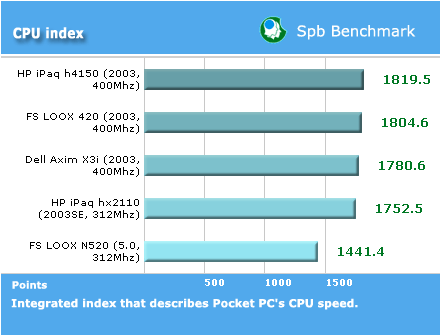
The integrated index describes the CPU speed. The model remains
behind the others, though uncritically.
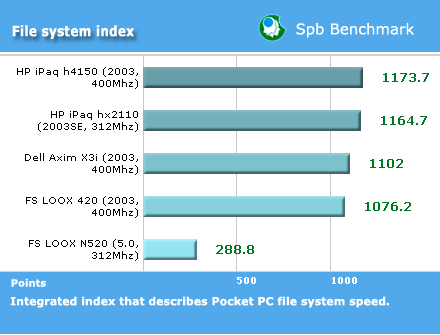
The file system test fails due to the memory reorganization. There
is no such lag in reality. The test is inadequate.
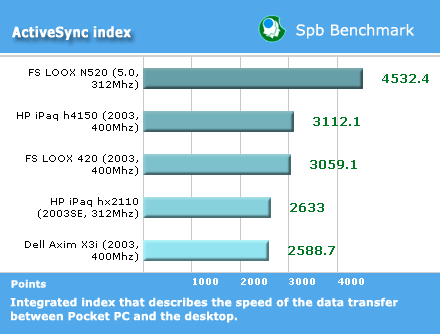
Due to an improved ActiveSync version, the model shows record speed
of synchronization.
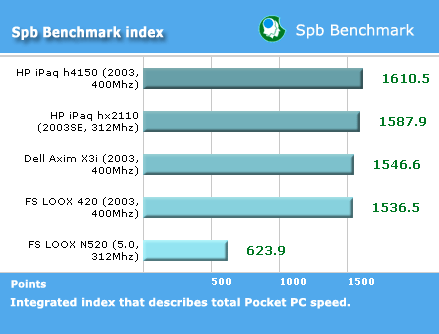
The total index seemed to represent the real picture of the PDA
productivity. If that is so, the N520 results are failure. But is
it right? The answer is negative. In fact, SPB Benchmark is unsuitable
to compare Pocket PC with different versions of operating system.
The distortion in the total index is caused by different memory
organization in the new version of Windows Mobile.
Here we will provide the test results in real applications; they
are much closer to the reality. The PDA showed the best results
at video playback. In our case, we launched 4 clips at different
stream intensity without Wireless MMX optimization (the function
of PXA270 processor), the index was formed on the basis of dropped
frames. The less dropped frames, the higher the index is. 1000 index
means no dropped frames at all.
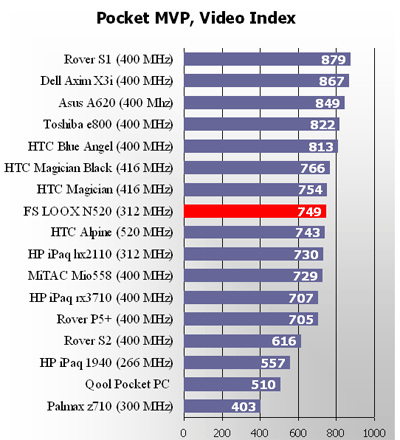
We see the Pocket LOOX N520 outpacing all the models with 312 MHz
processor. Given this clock rate (312 MHz) the clips ran surprisingly
smoothly.
To test graphics productivity we ran tests of the PocketQuake
game in the mute mode (turn the sound off by nosound 1 console command,
leaving other settings unchanged). There is an averaged figure by
2 tests (Demo 1 and Demo2). The test revealed good results.
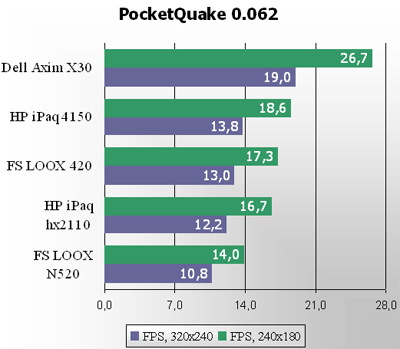
If, for some reason, you find the initial clock rate slow, you
can speed up the PDA (the only thing that can happen is hard reset
followed by data loss). We sped up the processor with XCPUScalar
utility, and productivity growth was measured with BetaPlayer, the
Wireless MMX optimization was on. The PDA worked steady only on
the clock rate less than 520 MHz, and further speed up made the
device freeze and work unsteady. As we see, the results are not
bad, though not the best. The PDA has enough productivity (with
the speed up) to cope with any tasks.

That’s the short resume on the productivity of the model.
Software
The PDA is powered by the fifth version of Windows Mobile. Details
about all the standard programs are available in a special review
on our site (though, you should realize there are no specific phone
applications in the LOOX N520), and here we tell about non-standard
programs in short. The set of extra programs is still poor. There
are no programs for data backup, though actually there is no need
in it taking into account the new memory organization.
- Review Windows Mobile 5.0 for Pocket PC


FSC VoiceRecorder. The voice recorder supports
WAV format. It differs from the integrated voice recorder in fine
settings and a capability to write info on a storage card.

FSC Panning. Holding a corresponding hardware
button the program is assigned to, you can move along the page in
Pocket IE using a stylus pen, it like drags the working area.
In Europe the model is supplied with the navigation program Navigon
version 5.
Conclusion
With the new N-series Fujitsu Siemens makes a move in the right
direction, the satellite navigation. Now we see the growing competition
among GSP solutions. And if earlier there was only the Taiwanese
company MiTAC on the market with its only product (MiTAC Mio168),
then now almost all the companies either offer or plan to introduce
own GPS solutions (we expect a GPS-PDA by HP). FS Pocket LOOX N520
is now one of the most attractive GPS PDAs on the market, though
it loses to HTC Galaxy in attraction, however there is a better
implemented GPS in the N520, it is more stable.
In its time the LOOX 420 really was a developed version of HP iPaq
4150 with a better screen and battery. The one maker produced both
devices - HTC. FS Pocket LOOX N520 with the forerunner’s design
can be called “the third edition, improved and supplemented”: a
GPS receiver (the main innovation), USB host, improved voice recorder,
a bit better battery and processor, new OS, but no Bluetooth. It
seems so from side. In fact, a well-known model LOOX 710 was taken
as the base (this very model is mentioned in the register of the
early sample), and many things get clear at once - USB host, voice
recorder, and new CPU. The developers replaced a CF slot with the
GPS module (no need to change the card for the new module), less
in size it allowed reducing the whole size of the device, and less
in weight (due to a less capacious battery). And now, I think it
won't be hard for you to guess what the N560 model with a VGA screen
is, and which model it is based on.
You should have a closer look at the model if you need the maximum
functional PDA with an attractive design (remember the CPU is easy
to speed up to 520 MHz), and do not care about the screen, the second
card slot and Bluetooth. The lowest price in Moscow for FS Pocket
LOOX N520 makes up some $390-400. The junior model N500 costs $340-350.
You’d better choose the latter, if you don’t need Wi-Fi.
Description:
- Class: middle;
- Position in the line: opening;
- Rival models: Asus MyPal A626, HTC Galaxy, HP iPaq rx1950;
- Operating system: Windows Mobile 5.0 for Pocket PC;
- Processor: Intel XScale PXA270 312 MHz;
- RAM: 64 MB (50.49 MB available);
- Flash-memory ROM: 128 MB (83.90 MB available);
- Interface: SD/MMC (SDIO), IrDA, Wi-Fi in the N520 (IEEE802.11g),
USB-client/host (synchronization, charging, connection with other
devices);
- Built-in GPS-receiver, SiRF Star III chip;
- LCD: 3.5” (active zone – 53x71 mm), 240x320 pixels, 65K colors;
- Battery: removable Li-Ion 1200 mAh;
- Dimensions: 116x71x14 mm;
- Weight: 145 g.
Anton Kotov
(anton.kotov@mobile-review.com)
Translated by Anja Rytchkova (anja.rytchkova@mobile-review.com)
Published — 24 April 2005
Have something to add?! Write us... eldar@mobile-review.com
|
News:
[ 31-07 16:21 ]Sir Jony Ive: Apple Isn't In It For The Money
[ 31-07 13:34 ]Video: Nokia Designer Interviews
[ 31-07 13:10 ]RIM To Layoff 3,000 More Employees
[ 30-07 20:59 ]Video: iPhone 5 Housing Shown Off
[ 30-07 19:12 ]Android Fortunes Decline In U.S.
[ 25-07 16:18 ]Why Apple Is Suing Samsung?
[ 25-07 15:53 ]A Few Choice Quotes About Apple ... By Samsung
[ 23-07 20:25 ]Russian iOS Hacker Calls It A Day
[ 23-07 17:40 ]Video: It's Still Not Out, But Galaxy Note 10.1 Gets An Ad
[ 19-07 19:10 ]Another Loss For Nokia: $1 Billion Down In Q2
[ 19-07 17:22 ]British Judge Orders Apple To Run Ads Saying Samsung Did Not Copy Them
[ 19-07 16:57 ]iPhone 5 To Feature Nano-SIM Cards
[ 18-07 14:20 ]What The iPad Could Have Looked Like ...
[ 18-07 13:25 ]App Store Hack Is Still Going Strong Despite Apple's Best Efforts
[ 13-07 12:34 ]Infographic: The (Hypothetical) Sale Of RIM
[ 13-07 11:10 ]Video: iPhone Hacker Makes In-App Purchases Free
[ 12-07 19:50 ]iPhone 5 Images Leak Again
[ 12-07 17:51 ]Android Takes 50%+ Of U.S. And Europe
[ 11-07 16:02 ]Apple Involved In 60% Of Patent Suits
[ 11-07 13:14 ]Video: Kindle Fire Gets A Jelly Bean
Subscribe
|

























